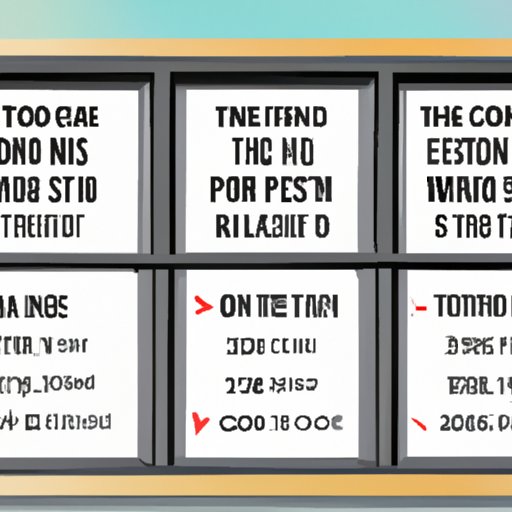Introduction
Window tinting is a popular way to improve the look of your car or home while providing practical benefits. It’s not just about style – tinted windows can also protect your car interior from UV rays and reduce glare, as well as potentially save you money on energy bills. But how much does it cost to window tint? In this article, we’ll explore the different costs associated with window tinting, from professional installation to DIY kits.

Comparing the Cost of Professional vs DIY Window Tinting
The cost of window tinting can vary depending on whether you choose to have it professionally installed or use a DIY kit. Professional window tinting is more expensive than DIY, but it offers several advantages such as a higher quality finish and a longer-lasting tint. According to Consumer Reports, “Most shops charge between $100 and $200 for sedan-size windows, and between $200 and $400 for an SUV or minivan, though prices are lower in some areas.”
When it comes to DIY window tinting, the cost depends on the type of film you use, but it’s generally much cheaper than professional installation. A basic DIY kit can cost as little as $20, while a high-quality kit can cost up to $100. However, it’s important to note that DIY window tinting takes time and patience, and if done incorrectly, it can damage your windows or even void your vehicle’s warranty.

An Overview of Window Tinting Prices by Brand and Type
The cost of window tinting also varies depending on the brand and type of film you choose. There are several types of window tint available, including dyed, metallic, ceramic, and hybrid films. Dyed films are the cheapest option, and usually cost between $100 and $200 for professional installation. Metallic films offer better heat protection and glare reduction, and typically cost between $150 and $300 for professional installation. Ceramic films are the most expensive option, costing between $250 and $400 for professional installation, but they offer superior protection against heat and UV rays.
In addition to the type of film, there are several brands of window tinting film available, each with their own pricing structures. Some of the most popular brands include 3M, Solar Gard, Llumar, and V-Kool. Generally speaking, these brands offer similar levels of quality, so it’s best to shop around and compare prices before making a decision.
The Benefits and Costs of Different Shades of Window Tint
The shade of window tint you choose can also affect the cost. Darker shades of tint generally provide better protection from UV rays and heat, but they can also be more expensive. According to Consumer Reports, “Darker tints cost more, sometimes double the price of lighter shades.” The exact cost will depend on the brand and type of film you choose, but expect to pay more for darker shades of tint.

Examining the Price Differences Between Tinting a Single Window vs Multiple Windows
If you’re looking to tint multiple windows, the cost can vary significantly depending on the number of windows you’re tinting. Generally speaking, the cost per window decreases when you tint multiple windows at once. For example, if you’re tinting four windows, the cost per window may be around $75, compared to $100 for a single window.
Tinting multiple windows at once can also provide other benefits, such as improved privacy and uniformity. When all of your windows are tinted, the overall look of your car or home is enhanced, creating a more stylish and cohesive appearance.
Analyzing the Cost of Installing Window Tint in Various Locations
The cost of window tinting can also vary depending on the location. For example, it may be more expensive to have your windows tinted in a city compared to a rural area. Other factors that can affect the cost include the size and shape of the windows, as well as the complexity of the job. If you’re tinting curved windows or intricate designs, expect to pay more as it’s a more difficult job.
Exploring How Much Window Tint Installation Can Save You on Energy Bills
In addition to its aesthetic benefits, window tinting can also help you save money on energy bills. According to the US Department of Energy, “Properly applied window film can reduce heating and cooling costs by up to 25%.” This means that if you’re paying $100 a month on energy bills, window tinting could potentially save you up to $25 a month.
To calculate your estimated savings, multiply the total square footage of your windows by the cost of your energy bill. Then, multiply the result by 0.25 to get your estimated savings from window tinting. For example, if you have 100 square feet of windows and your energy bill is $100 a month, you could potentially save $25 a month from window tinting.
Conclusion
Window tinting can provide a range of benefits, from protecting your car interior to reducing your energy bills. The cost of window tinting varies depending on whether you choose professional installation or DIY, as well as the type and brand of film you choose. Darker shades of tint are more expensive, but they offer superior protection from heat and UV rays. And finally, window tinting can save you money on energy bills, with potential savings of up to 25%.
So, how much does it cost to window tint? The answer depends on a variety of factors, from the type and brand of film you choose to the number of windows you’re tinting. Ultimately, the cost of window tinting is well worth the money, as it can provide both aesthetic and practical benefits.
(Note: Is this article not meeting your expectations? Do you have knowledge or insights to share? Unlock new opportunities and expand your reach by joining our authors team. Click Registration to join us and share your expertise with our readers.)
